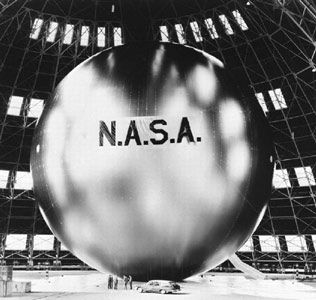
Home - Search - Browse - Alphabetic Index: 0- 1- 2- 3- 4- 5- 6- 7- 8- 9
A- B- C- D- E- F- G- H- I- J- K- L- M- N- O- P- Q- R- S- T- U- V- W- X- Y- Z
Echo
 Echo Credit: NASA |
Status: Operational 1960. First Launch: 1960-05-13. Last Launch: 1960-08-12. Number: 2 . Gross mass: 66 kg (145 lb). Height: 41.10 m (134.80 ft).
Each spacecraft was a large metallized balloon designed to act as a passive communications reflector to bounce communication signals transmitted from one point on Earth to another.
Following the failure of the launch vehicle carrying Echo 1, Echo 1A (commonly referred to as Echo 1) was successfully orbited, and was used to redirect transcontinental and intercontinental telephone, radio, and television signals. The success of Echo 1A proved that microwave transmission to and from satellites in space was understood and demonstrated the promise of communications satellites. The vehicle also provided data for the calculation of atmospheric density and solar pressure due to its large area-to-mass ratio. Echo 1A was visible to the unaided eye over most of the Earth (brighter than most stars) and was probably seen by more people than any other man-made object in space. Echo 2 continued the passive communications experiments, and also investigated the dynamics of large spacecraft and was used for global geometric geodesy. Although NASA abandoned passive communications systems in favor of active satellites following Echo 2, the Echo systems demonstrated several ground station and tracking technologies that would be used by active systems. Echo 1A re-entered on May 24, 1968 followed by Echo 2 on June 7, 1969.
Echo 1 and 1A were 30.5 m diameter balloons made of 0.0127 mm thick Mylar polyester film. A set of 107.9-MHz beacon transmitters were carried for telemetry. The transmitters were powered by five nickel-cadmium batteries that were charged by 70 solar cells mounted on the balloon. Echo 2 was a 41.1 m diameter Mylar balloon that used an improved inflation system to improve the balloon's smoothness and sphericity. Instrumentation included temperature sensors to monitor the balloon's skin temperature and pressure sensors to monitor the balloon's internal pressure. A beacon system, consisting of two transmitter assemblies, provided tracking and telemetry signals. The beacon system used solar cell panels for power and had a minimum power output of 45 mW at 136.17 MHz and 136.02 MHz. No scientific payloads were carried on any of the missions. Echo 1's surface was used to reflect 960 and 2390 MHz signals. Echo 2 experimenters utilized 162 MHz signals.
| Echo 1, 1A Communication, passive satellite built by G. T. Schjeldahl Co. (Balloon); Kaiser-Fleetwings Co. (Container) for NASA, USA. Launched 1960. |
| Echo 2 American passive communications satellite. Passive communications satellite; balloon; 1st joint US/USSR space mission. |
Family: Communications, Medium earth orbit, Passive communications satellite, Technology. Country: USA. Launch Vehicles: Thor, Delta, Thor Delta. Launch Sites: Cape Canaveral, Cape Canaveral LC17A. Agency: NASA, NASA Langley, Grumman, Sheldahl. Bibliography: 126, 2, 3674, 3675, 3676, 3677, 3678, 3679, 3680, 3681, 3682, 3683, 3684, 3685, 3686, 3687, 3688, 3689, 3690, 3691, 6.
 | Echo 1 Credit: Manufacturer Image |
1960 May 13 - . 09:16 GMT - . Launch Site: Cape Canaveral. Launch Complex: Cape Canaveral LC17A. LV Family: Thor. Launch Vehicle: Thor Delta. FAILURE: Second stage attitude control failure.. Failed Stage: U.
- Echo 1 - .
Payload: A-10. Mass: 56 kg (123 lb). Nation: USA.
Agency: NASA.
Class: Communications.
Type: Civilian communications satellite. Spacecraft: Echo.
Decay Date: 1960-05-13 .
The first three-stage, NASA-developed Thor/Delta space booster was launched from Cape Canaveral, but the Echo passive communications satellite failed to achieve orbit due to a second stage malfunction. This booster was for NASA programs and used the basic Thor first stage with a modified Vanguard second stage as its upper stage configuration.
1960 August 12 - . 09:39 GMT - . Launch Site: Cape Canaveral. Launch Complex: Cape Canaveral LC17A. LV Family: Thor. Launch Vehicle: Thor Delta.
- Echo 1 - .
Payload: A-11. Mass: 76 kg (167 lb). Nation: USA.
Agency: NASA.
Class: Technology.
Type: Communications technology satellite. Spacecraft: Echo.
Decay Date: 1968-05-24 . USAF Sat Cat: 49 . COSPAR: 1960-Iota-1. Apogee: 2,157 km (1,340 mi). Perigee: 966 km (600 mi). Inclination: 47.30 deg. Period: 117.30 min.
A Thor/Delta was launched from Cape Canaveral carrying NASA's Echo I, the first passive communications satellite to be placed into orbit. Balloon; passively relayed TV and voice transmissions. Spacecraft engaged in practical applications and uses of space technology such as weather or communication (US Cat C).
1964 January 25 - . 13:59 GMT - . Launch Site: Vandenberg. Launch Complex: Vandenberg SLC2E. LV Family: Thor. Launch Vehicle: Thor SLV-2 Agena B.
- Echo 2 - . Payload: Echo C A-12. Mass: 256 kg (564 lb). Nation: USA. Agency: NASA Langley. Class: Technology. Type: Communications technology satellite. Spacecraft Bus: Echo. Spacecraft: Echo 2. Decay Date: 1969-06-07 . USAF Sat Cat: 740 . COSPAR: 1964-004A. Apogee: 1,315 km (817 mi). Perigee: 1,030 km (640 mi). Inclination: 81.50 deg. Period: 108.80 min. Passive commsat; balloon; 1st joint US/USSR space mission. Spacecraft engaged in practical applications and uses of space technology such as weather or communication (US Cat C). .
Back to top of page
Home - Search - Browse - Alphabetic Index: 0- 1- 2- 3- 4- 5- 6- 7- 8- 9
A- B- C- D- E- F- G- H- I- J- K- L- M- N- O- P- Q- R- S- T- U- V- W- X- Y- Z
© 1997-2019 Mark Wade - Contact
© / Conditions for Use